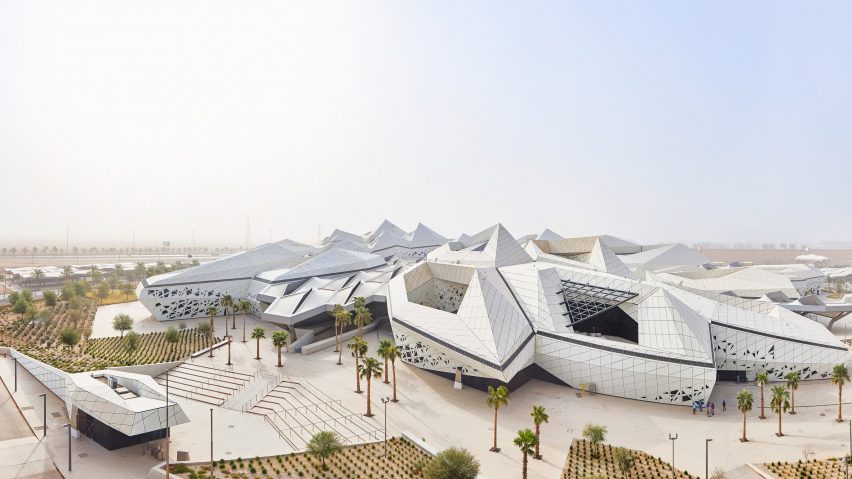Hexagonal pods interlock like honeycomb to form the King Abdullah Petroleum Studies and Research Centre, built by Zaha Hadid Architects in the Saudi Arabian capital Riyadh.
The huge building was designed by London-based Zaha Hadid Architects to provide facilities for researchers investigating the transition towards more sustainable power sources in one of the most oil-rich countries in the world.
With a mission to research the most effective use of energy, the King Abdullah Petroleum Studies and Research Centre (KAPSARC) has been designed to achieve a LEED Platinum sustainability certification.
The modular honeycomb formation of the building allows for future adaption and expansion of the research campus. The faceted form of the cells is highlighted by angular cut outs in their flanks and latticed skylights.
This layout is one of several passive and active systems that aim to minimise energy consumption in the hot desert climate of Riyadh.
"Hexagonal prismatic honeycomb structures use the least material to create a lattice of cells within a given volume," explained the studio.
"This structural and organisational principle determined KAPSARC's composition as an amalgamation of crystalline forms that emerges from the desert landscape, evolving to best respond to the environmental conditions and internal programme requirements."
Similarly, rooftop solar panels have a capacity to store up to a huge 5,000 megawatts per year, and potable water is recycled and reused across the site.
The 70,000-square-metre facility comprises five interconnected buildings: the Energy Knowledge Centre, the Energy Computer Centre, the Conference Centre, the Research Library and the Musalla prayer space.
The pods are oriented to lessen the impact of the harsh light and heat of the Riyadh Plateau, and a public courtyard at the centre of the campus is shaded by canopies on branching columns.
The building lifts from the ground to the north and west of the site to allow any breeze to permeate to the courtyard.
During the hottest parts of the year, researchers can travel between the different buildings via an underground passage.
A series of smaller courtyards are also provided by the gaps left where the pods angle away from each other, and are cooled by "wind-catchers" built into the roof profiles.
Zaha Hadid Architects is also currently working on an archeology centre for a UNESCO-protected site in Saudi Arabia, which will be dedicated to protect the archaeological sites of Wadi Hanifah, a 120-kilometre-long valley that cuts through the city of Diriyah.
Photography is by Hufton + Crow.
Project credits:
Architect: Zaha Hadid Architects
Architectural design: Zaha Hadid, Patrik Schumacher
ZHA project director: Lars Teichmann, Charles Walker
ZHA design director: DaeWha Kang
ZHA project site team: John Simpson (site associate), Alejandro Diaz, Anas Younes, Annarita Papeschi, Aritz Moriones, Ayca Vural Cutts, Carlos Parraga-Botero, Javier Rueda, Malgorzata Kowalczyk, Michal Wojtkiewicz, Monika Bilska, Sara Criscenti, Stella Dourtme
ZHA project leaders: Fabian Hecker (research center), Michael Powers (conference center), Brian Dale/Henning Hansen (library), Fulvio Wirz (musalla/IT center), Elizabeth Bishop (facades/2d documentation), Saleem A Jalil/Maria Rodero (master plan), Lisamarie Ambia/Judith Wahle (interiors), Bozana Komljenovic (2d documentation), John Randle (specifications), John Szlachta (3d documentation coordinator)
ZHA project team: Adrian Krezlik, Alexander Palacio, Amdad Chowdhury, Amit Gupta, Andres Arias Madrid, Britta Knobel, Camiel Weijenberg, Carine Posner, Claire Cahill, Claudia Glas-Dorner, DaChun Lin, Daniel Fiser, Daniel Toumine, David Doody, David Seeland, Deniz Manisali, Elizabeth Keenan, Evan Erlebacher, Fernanda Mugnaini, Garin O’Aivazian, Giorgio Radojkovic, Inês Fontoura, Jaimie-Lee Haggerty, Jeremy Tymms, Julian Jones, Jwalant Mahadevwala, Lauren Barclay, Lauren Mishkind, Mariagrazia Lanza, Melike Altinisik, Michael Grau, Michael McNamara, Mimi Halova, MohammadAli Mirzaei, Mohammed Reshdan, Muriel Boselli, MyungHo Lee, Nahed Jawad, Natacha Viveiros, Navvab Taylor, Neil Vyas, Nicola McConnell, Pedro Sanchez, Prashanth Sridharan, Roxana Rakhshani, Saahil Parikh, Sara Saleh, Seda Zirek, Shaju Nanukuttan, Shaun Farrell, Sophie Davison, Sophie Le Bienvenu, Stefan Brabetz, Steve Rea, Suryansh Chandra, Talenia Phua Gajardo, Theodor Wender, Yu Du
ZHA competition design team: Lisamarie Ambia, Monika Bilska, Martin Krcha, Maren Klasing, Kelly Lee, Johannes Schafelner, Judith Schafelner, Ebru Simsek, Judith Wahle, Hee Seung Lee, Clara Martins, Anat Stern Daniel Fiser; Thomas Sonder, Kristina Simkeviciute, Talenia Phua Gajardo, Erhan Patat, Dawna Houchin, Jwalant Mahadevwala
Engineering: Arup
Interior design: Woods Bagot
Landscape design: GROSS.MAX
Lighting design: OVI
Catering and kitchen design: Eastern Quay and GWP
Exhibition design: Event
Artwork:International Art Consultants
Branding and signage: Elmwood and Bright 3d
Library consulting: Tribal
Cost consulting and design project management: Davis Langdon

